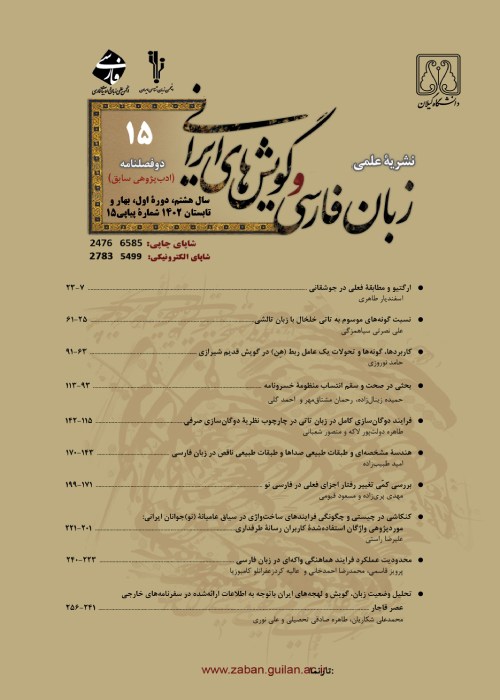Feature Geometry, Natural Segments, and Incomplete Natural Classes of Sounds in Persian
In this article, first the distinctive features of Persian phonological system based on articulatory features have been described, then the feature specification of 29 Persian phonemes in two tables of consonants and vowels have been presented. In the next section, the theory of feature geometry and such concepts as feature tree and segment trees have been briefly explained. The final part of this article deals with some incomplete natural classes.
Trubetzkoy (1939) and Jakobson (1941), and especially Jakobson and Halle (1956), spoke about distinctive features for the first time. They introduced these features mainly based on the acoustic characteristics, but due to the poor technologies of the sound analysis devices at that time, they could not do the job as they should. About a decade later, Chomsky and Halle (1968) replaced acoustic features with articulatory distinctive features and presented the first table of articulatory distinctive features. With the improvement of the level of acoustics studies, some researchers again tried to adjust these tables according to acoustics features, but articulatory distinctive features also maintained their importance and underwent many developments and changes (for example, see Gussenhoven and Jacobs 2017: 64-75).
In early distinctive features tables, the order of presentation of features was not very important and these features were presented in any arbitrary order, but during the research that resulted in feature geometry, features were included in a tree-like hierarchical structure called feature tree (Clements & Hume 1996: 245). Now, based on this hierarchical structure, for which several forms have been introduced so far, it is possible to determine the order of presentation of features within the features tables as well as the matrices of each sound.
In this article, we try to specify the Persian phoneme features based on their articulatory properties, and then introduce the phoneme feature table of this language based on the model presented by Gussenhoven and Jacobs (2017: 64-75). Based on the theory of feature geometry then, we display the feature tree of this language and extract segment trees of individual Persian phonemes from it.
In the last part of this article, by mentioning some examples, we show the use of feature analysis in explaining the natural classes of sounds and the natural classes of features, and then we talk about the natural class of long and short Persian vowels. We will see that these two natural classes in Persian have some characteristics of natural classes, and lack some others, and therefore we call them incomplete natural classes. In this part, I introduce two natural segment classes of the so-called long and short vowels in Persian, i.e., /i α u/ and /e a o/ respectively. Natural segment classes are groups of phonemes with two characteristics: firstly, that the language has the same behavior with them, and secondly that the number of features necessary to describe each class must be less than the number of features necessary to describe each member of that class. I will show that /i α u/ and /e a o/ are natural segment classes only based on the first characteristics and not the second one. This contradiction may be related to the historical changes of Persian phonological system, in which quantity used to be a distinctive feature, but today it no longer has such a role. I suggest that such classes having one of the two conditions of natural classes, to be called incomplete natural classes.
In this article, I described Persian distinctive features based on their articulatory properties, then included those features in the hierarchical structure of a feature tree according to the theory of feature geometry. I determined the order of presentation of features in this table, based on a feature tree, and based on the same tree, I displayed segment trees of all Persian phonemes. Describing the natural segment and feature classes is another topic of this article. In the final part of this article, I talked about the importance of feature analysis in explaining natural segment and feature classes with some examples, and at the end, I talked about the possibility of incomplete natural segment classes versus complete natural segment classes in languages.
- حق عضویت دریافتی صرف حمایت از نشریات عضو و نگهداری، تکمیل و توسعه مگیران میشود.
- پرداخت حق اشتراک و دانلود مقالات اجازه بازنشر آن در سایر رسانههای چاپی و دیجیتال را به کاربر نمیدهد.



